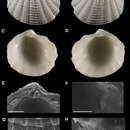Radiolucina amianta: Brief Summary
provided by wikipedia EN
Lucina amiantus, or the decorated lucine, is a species of bivalve mollusc in the family Lucinidae.
It can be found along the Atlantic coast of North America, from North Carolina to the West Indies and Brazil.
- license
- cc-by-sa-3.0
- copyright
- Wikipedia authors and editors
Description
provided by Zookeys
Shell shape. Subovate, extended anteriorly and posteriorly, length longer than height, slightly inflated; maximum length: 6.0 mm, maximum height: 6.0 mm.
Sculpture and color. About 11 (n=2) non-bifurcating radial ribs, overlain by thin commarginal lamellae that continue through interspaces, producing a reticulate pattern; occasional intercalary ribs present; interspaces shallow, thin towards beak and progressively widening ventrally; anterior and posterior ends smooth with fine commarginal striae, posterior sometimes with spines of varying heights protruding from shell; inner shell margin finely crenulate; interior color tan, shiny.
Hinge. Hinge plate thick, curved on either side of cardinal teeth; beaks prosogyrate; cardinal teeth small, right valve posterior tooth thin, anterior tooth thick, left valve middle tooth wide; lateral teeth large, posterior tooth vertical, anterior tooth horizontal; ligament sunken above cardinal teeth.
Adductor scars and pallial line. Pallial line continuous; anterior adductor scar long, narrow, diverging from pallial line for about a quarter of its length; posterior adductor scar small, wide, pallial line joins at most ventral point.
- license
- cc-by-3.0
- copyright
- Elizabeth A. R. Garfinkle
- bibliographic citation
- Garfinkle E (2012) A review of North American Recent Radiolucina (Bivalvia, Lucinidae) with the description of a new species ZooKeys 205: 19–31
- author
- Elizabeth A. R. Garfinkle
Distribution
provided by Zookeys
Western Atlantic from North Carolina to Florida, West Indies, Gulf of Mexico, Caribbean Central America, South America south to Uruguay (Mikkelsen and Bieler 2007).
- license
- cc-by-3.0
- copyright
- Elizabeth A. R. Garfinkle
- bibliographic citation
- Garfinkle E (2012) A review of North American Recent Radiolucina (Bivalvia, Lucinidae) with the description of a new species ZooKeys 205: 19–31
- author
- Elizabeth A. R. Garfinkle

